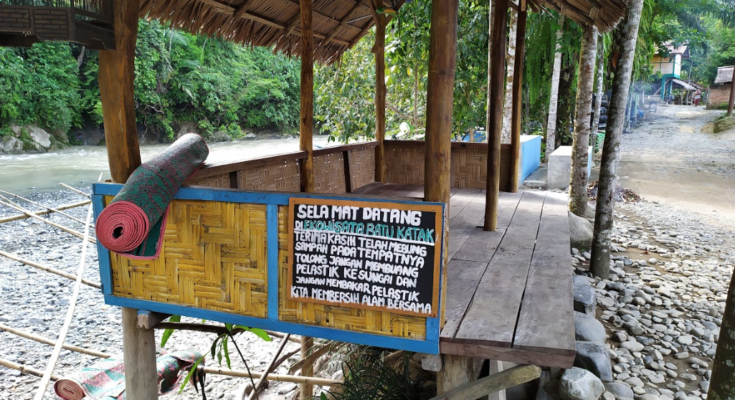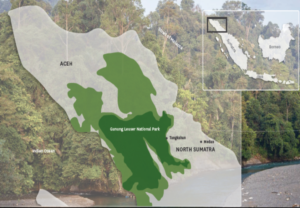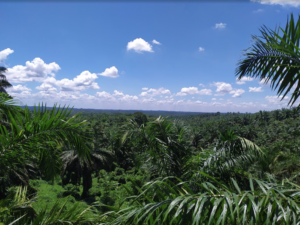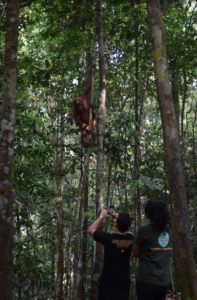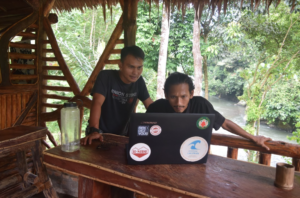Community-Based Ecotourism as a Way to Ensure Nature Conservation, and Well-being in North Sumatra, Indonesia
by Roderick T.J. Buiskool, M.A.
Orangutan and infant inside the Mount Leuser National Park. Photo: Frederick G.J. Buiskool.
“Working as an ecotourism guide has always been my dream. I love to meet new people and I feel that it is an honourable job, in terms of conserving nature, so I work from the heart”- An ecotourism guide from Batu Katak hamlet bordering the Mount Leuser National Park.
Indonesia is the fourth most populous country in the world, and according to the World Bank, it boasts the tenth largest economy in the world, and it is the largest economy in Southeast Asia. Indonesia also contains the world’s second largest expanse of tropical forest, and it is a world renowned and popular tourism and ecotourism destination.
However, long-term development in Indonesia is threatened by environmental degradation and climate change, as much of the country’s economic growth has been driven by the extraction of natural resources at the expense of the environment, such as deforestation to make way for monoculture plantations.
One of the main challenges for Indonesia is to reduce poverty and inequality, whilst also conserving its natural resources. Additionally, with the ongoing Covid-19 pandemic, now more than ever people are becoming aware of the link between human health and the health of the ecosystem, where protecting nature and biodiversity hotspots has become increasingly crucial.
In Indonesia, the island of Sumatra stands out due to the intensive deforestation that has resulted in the conversion of 70% of the island’s forested area up until 2010. The deforestation of the pristine and overwhelming biodiversity areas happens because of reasons interlinked with livelihoods.
The Leuser Ecosystem shown in light green. The Mount Leuser National Park in dark green.
The Mount Leuser National Park
The Mount Leuser National Park in North Sumatra is an area with a high deforestation rate, and at the same time it is also a high priority for biodiversity conservation. This particular National Park is home to critically endangered fauna such as the Sumatran orangutan (Pongo abelii), ‘siamang’ or black-furred gibbon (Symphalangus syndactylus), Malayan sun bears (Helarctos malayanus), Sumatran elephants (Elephas maximus sumatranus), Sumatran rhino (Dicerorhinus sumatrensis), and the Sumatran tiger (Panthera tigris sumatrensis).
Some of the critically endangered species inside the Mount Leuser National Park.
Even though the Mount Leuser National Park is officially protected by its status as an Indonesian national park, it still remains under severe threat of deforestation. In just the past five years, the Mount Leuser National Park has lost 20% of its lowland forests to illegal commercial activities. According to the World Resources Institute, monoculture plantations such as palm oil and rubber encroach into the Mount Leuser National Park, leading to a deforestation rate of 3,000 acres (12 square kilometres) per year!
Palm oil plantations as far as one can see, bordering the Mount Leuser National Park. Photo: Roderick T.J. Buiskool
Deforestation of the Sumatran rainforest has severe knock-on-effects including the decline in ecological functions, vital for the lives and well-being of the population living in the region, such as fresh water supply, prevention of soil-erosion and floods, and of course climate regulation. Additionally, deforestation also negatively impacts local economies due to the loss of income from ecotourism opportunities, as ecotourism tends to create many jobs, such as ecotourism guides, kiosks, warungs (small restaurants), homestays and many more tourism related jobs.
Conserving Nature through Ecotourism?
Given that the main driver of deforestation in the Mount Leuser National Park is interlinked with livelihoods, a sustainable source of income for the local population living adjacent to the park is crucial to reduce it. Ecotourism is said to be one of the ways to conserve nature and biodiversity, and at the same time increases socio-economic development, and well-being of the local population.
So what exactly is ecotourism? The International Ecotourism Society defines it as “responsible travel to natural areas, which conserves the environment and sustains well-being of the local people”. Ecotourism requires the following seven components: (1) involves nature based tourism; (2) reduces adverse environmental impact; (3) strengthens environmental awareness; (4) provides direct financial benefits for conservation; (5) delivers financial benefits and empowerment for local people; (6) respects local culture; and (7) supports human rights and democratic movements.
More specifically, Community-Based Ecotourism which is a form of ecotourism, is argued to be a mutually reinforcing relationship between conservation, and sustainable livelihoods. The World Wide Fund for Nature (WWF) defines it as ‘a practice of tourism where the local community has a significant control over, its development and management, where a major percentage of the benefits stay within the community’.
Thus, its aim is to promote conservation and ecological sustainability, by providing the possibility for an alternative livelihood of the local population without degrading nature, therefore contributing to the well-being of forest-edge communities, and increases incentives for conservation of biodiversity through income generation.
Tourists spotting orangutans inside the Mount Leuser National Park. Photo: Roderick T.J. Buiskool
For Indonesia, tourism currently is an important source of income, coming second after palm oil exports. In the context of the Mount Leuser National Park, ecotourism is a significant source of income, especially for some forest-edge ecotourism destinations adjacent to the Mount Leuser National Park.
A Case Study: Community-Based Ecotourism in the Batu Katak Hamlet Bordering the Mount Leuser National Park
“Overall I feel that my life has improved a lot and I have really felt a positive influence on my life from ecotourism”- A local Ecotourism guide in Batu Katak
Community-Based Ecotourism CBE has been regarded as an important income generating strategy that does not harm nature in many destinations bordering the Mount Leuser National Park. This is evident in Batu Katak which is a small ecotourism destination nestled on the edge of the Park, and is a three hour drive from the city of Medan, the capital of North Sumatra.
Batu Katak is located alongside the Berkail River where many ecotourism activities take place such as jungle trekking, caving, bird watching, camping, wild water rafting, and wildlife spotting, including the endangered orangutans, gibbons and if you are (un)lucky the Sumatran tiger. Additionally, many cultural, mainly Karo, attractions take place in Batu Katak, including traditional dance performances, traditional medicine gardens, as well as cooking lessons for those interested in the local Karo culinary delicacies.
Besides being located adjacent to the Park, Batu Katak also has a captivating Karst Forest next to it. The Karst Forest is a distinctive ecosystem where the area of land is made up of limestone, and creates a landscape that features dramatic vertical cliffs, underground streams, springs and often complex cave systems. The karst forest is locally referred to as the Gunung Kapur (Limestone Mountain).
The combination of the panorama of the Berkail River, and the presence of critically endangered flora and wildlife in the Mount Leuser National Park, and the Limestone Mountain, makes Batu Katak a fascinating ecotourism destination, as well as an area with a high conservation value.
Local ecotourism guides in Batu Katak. Photo: Roderick T.J. Buiskool
Tourism development in Batu Katak has been initiated by the local community because many in the local community wanted to increase their overall quality of life and well-being, by reducing reliance on, and problems associated with illegal logging.
Opportunities and Challenges for CBE as a way to ensure Conservation and well-being
CBE in Batu Katak has the potential to improve the well-being of the local residents by paving the way for an additional source of income whilst conserving the biodiversity. However, it is not without challenges. Some of the main challenges faced by the local population since Community Based Ecotourism in Batu Katak are: the worsening of the water quality in the Berkail River due to tourism related water pollution, persisting deforestation, inequality of economic benefits from the tourism industry, and ongoing human wild-life conflict, for instance orangutans raiding durian plantations of local farmers, leading to a loss of crops and income. Lastly, the ‘shock’ of the ongoing Covid-19 Pandemic also has been a big challenge, which has made many people working in the sector doubt whether ecotourism is a viable strategy to gain income.
The Importance of a Diversified and Sustainable Livelihood Strategy
The Covid-19 pandemic has spotlighted the importance of diversified sustainable livelihoods to ensure conservation of nature and well-being. As is evident in Batu Katak, Community-Based Ecotourism is mainly seen as an additional source of income. Even though, the Covid-19 pandemic has had a negative influence on the well-being of the residents, however, given that most residents are not totally dependent on tourism, and have diversified livelihood strategies, their lives have not been as severely impacted as those people that are exclusively dependent on tourism, as is currently evident in neighbouring and more well-known Bukit lawing village, but also in Bali.
Therefore in the wake of the Covid-19 pandemic, a combination of community-based ecotourism, conservation, and sustainable agriculture would enhance the resilience of the local communities, and improve overall sustainable livelihoods and well-being.
References
Main Office MLNP. (2014). Ecotourism Mountain Leuser National Park. http: //gunungleuser.or.id Retrieved 15 June, 2017
Margono, B., Turubanova, S., Zhuravleva, I., Potapov, P., Tyukavina, A., & Baccini, A. et al. (2012). Mapping and monitoring deforestation and forest degradation in Sumatra (Indonesia) using Landsat time series data sets from 1990 to 2010. Environmental Research Letters, 7(3), 034010. doi: 10.1088/1748-9326/7/3/034010
Mathevet, R., Bousquet, F., & Raymond, C. M. (2018). The concept of stewardship in sustainability science and conservation biology. Biological Conservation, 217, 363–370. doi: 10.1016/j.biocon.2017.10.015
Mccarthy, J. F. (2002). Power and Interest on Sumatras Rainforest Frontier: Clientelist Coalitions, Illegal Logging and Conservation in the Alas Valley. Journal of Southeast Asian Studies, 33(1), 77-106. doi:10.1017/s0022463402000048
TIES. 2020. “The International Ecotourism Society: What is Ecotourism?”, Accessed 11 November. https://ecotourism.org/what-is-ecotourism/.
United Nations Educational, Scientific and Cultural Organization (UNESCO) (2019). Retrieved 16 December 2019, from http://www.unesco.org/new/en/natural-sciences/environment/ecological-sciences/biosphere-reserves/asia-and-the-pacific/indonesia/gunung-leuser
van Beukering, P., Cesar, H., & Janssen, M. (2003). Economic valuation of the Leuser National Park on Sumatra, Indonesia. Ecological Economics, 44(1), 43-62. doi: 10.1016/s0921-8009(02)00224-0
World Resources Institute (2018). “Local Communities Restore Two of Indonesia’s Most Threatened National Parks”. https://www.wri.org/blog/2018/11/local-communities-restore-two-indonesias-most-threatened-national-parks
World Wildlife Fund (WWF), (2001). “Community-Based Eco Tourism Community Interests MeetEnvironmentalResponsibility”.https://www.wwf.or.id/en/about_wwf/whatwedo/pds/social_development/communitybasedecotourism/
Yuliana, Y., and Indarjo, S. “Pengembangan Ekowisata Batu Katak Melalui Metode Swot Analisis.” Talenta Conference Series: Agricultural and Natural Resources (ANR) 1, no. 2 (2018): 231–37. doi:10.32734/anr.v1i2.243.

